It’s easy to see why this oasis off the coast of Madagascar, in the south-east of the African continent, fascinated navigators of yesteryear. Mauritius was officially discovered by an expedition of Portuguese explorers around 1500, when a cyclone diverted the flotilla from its course towards the Mascareignes Archipelago (Reunion, Mauritius, Rodrigues).

Almost a century later, the French seized the island, renamed Isle de France, and developed a prosperous economy based on sugar cane cultivation. The island was taken by force by the British in 1810 and renamed Mauritius, before gaining independence in 1968. The pearl of the Indian Ocean quickly aroused curiosity, becoming a real source of inspiration for novelists such as Mark Twain and the naturalist and father of the theory of evolution, Charles Darwin. Indeed, this island paradise is still home to a rich diversity of flora and fauna, both on its land and in the ocean that surrounds it. There are many ways to discover the richness of this little jewel. For hikers and adventurers, a visit to the Chamarel geopark is a must to see the Land of 7 Colours, a clearing made up of undulating strips of sand in 7 different hues. This unique landscape is the result of the presence of volcanic ash containing different-coloured mineral oxides, exposed by centuries of erosion. It’s a breathtaking sight that reveals a piece of the world’s beauty. As the Chamarel estate is a nature reserve, you can also discover wildlife such as Java deer, giant tortoises and peacocks of rare splendour.

On the south-east side, discover the Vallée de Ferney nature reserve, a 3,100-hectare private estate rich in unique biodiversity, lush hiking trails and farms with a sustainable farming ecosystem. And for the more adventurous, to the west lies one of the greatest mysteries of Mauritian nature: the three Mamelles, a mountain range of verdant landscapes, with three peaks rising to 600 m, offering breathtaking panoramic views. For those who prefer the deep sea, Flicen-Flac is the ideal place for snorkelling enthusiasts. A transparent, shallow lagoon with generally weak currents, offering reefs perfect for aquatic life. When it comes to gastronomy, the island of a thousand flavours is brimming with spices, exotic fruits and exceptional teas, as well as seafood and fresh fish sold in the various market stalls dotted around the island. Here, you’ll discover real local life and the joy of a positively energetic people.


Let yourself wander through the maze of colourful, vanilla-scented alleys, and don’t hesitate to chat with the market vendors, who’ll be happy to give you tips on the best places to eat and recipes for typical dishes. As you can see, Mauritius offers much more than blue lagoon waters, fine sandy beaches and lush green forests: it’s a true reconnection with nature and its environment, a gentle way of life that encourages you to contemplate, not forgetting the infectious joie de vivre of its inhabitants who will make your trip unforgettable.
